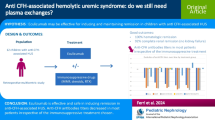Abstract
Review of data from 79 children with the haemolytic uraemic syndrome (HUS) showed that the polymorphonuclear leucocyte (PMN) count at presentation in childhood HUS predicts outcome. Logistic regression analysis of several features at presentation identified only the PMN count and the presence of a diarrhoeal prodrome as having a significant effect on the outcome (P<0.01 andP<0.001 respectively). The geometric mean PMN count was significantly raised in 70 children who had typical HUS following a diarrhoeal prodrome (D+cases) compared with that of 9 children who had atypical disease without diarrhoea (D-cases) (t-test on log-transformed data,P<0.005). Fifty-seven children with D+HUS who recovered completely had a significantly lower geometric mean PMN count than D+cases with a bad outcome (P<0.001). Four of these patients, who died in the acute stage of the disease, had a significantly higher mean count than the rest of the D+patients (P<0.001). Multiple regression analysis demonstrated that the PMN count in D+cases was not significantly influenced by haemoglobin concentration, platelet count, length of the prodrome, or the administration of antibiotics in the prodromal period. A high PMN count at presentation in D+HUS indicates a poor prognosis. The data emphasise the heterogeneity of HUS and suggest that PMN participate in the pathogenesis of the disorder in typical D + cases but not in atypical D- cases.
Similar content being viewed by others
References
Levin M, Barratt TM (1984) Haemolytic uraemic syndrome. Arch Dis Child 1984: 59:397–400
Anderson JA (1980) Logistic discrimination. In: Krishnaiah PR (ed) Handbook of statistics, vol 2. North Holland, New York
Kaplan BS, Chesney RW, Drummond KN (1975) Hemolytic uremic syndrome in families. N Engl J Med 292: 1090–1093
Trompeter RS, Schwartz R, Chantler C, Dillon MJ, Haycock GB, Kay R, Barratt TM (1983) Haemolytic uraemic syndrome: an analysis of prognostic features. Arch Dis Child 58:101–105
Dolisager D, Tune B (1978) The hemolytic uremic syndrome: spectrum of severity and significance of prodrome. Am J Dis Child 132:55–58
Habib R, Levy M, Gadnadoux M, Broyer M (1982) Prognosis of the hemolytic uremic syndrome in children. In: Hamburger J (ed) Proceedings of the Necker Hospital. Year Book Medical, Chicago, pp 99–127
Levin M, Stroobant P, Walters MDS, Cheng DJ, Waterfield MD, Barratt TM (1986) Platelet-derived growth factors are possible mediators of vascular proliferation in the sporadic haemolytic uraemic syndrome. Lancet II: 830–833
Kamali MA, Steele BT, Petric M, Lim C (1983) Sporadic cases of haemolytic uraemic syndrome associated with faecal cytotoxin and cytotoxin-producingEscherichia coli in stools. Lancet I:619–620
Wells JG, Davis BR, Wachsmith IK, Riley LW, Remis RS, Sokolow R, Morris GK (1983) Laboratory investigation of hemorrhagic colitis outbreaks associated with a rareEscherichia coli serotype. J Clin Microbiol 18: 512–520
Harlan JM, Killen PD, Harker LA, Striker GE (1981) Neutrophil-mediated endothelial injury in vitro. J Clin Invest 68:1394–1403
Smedly LA, Tonnesen MG, Sandhaus RA, Haslet C, Guthrie LA, Johnson PM, Henson PM, Worthen GS (1986) Neutrophil-mediated injury to endothelial cells. J Clin Invest 77:1233–1243
Vedanarayanan VV, Kaplan BS, Fong JSC (1987) Neutrophil function in an experimental model of hemolytic uremic syndrome. Pediatr Res 21:252–256
Sacks T, Moldow CF, Craddock PR, Bowers TK, Jacob HS (1978) Oxygen radicals mediate endothelial cell damage by complement stimulated granulocytes. J Clin Invest 61:1161–1167
Weiss SJ, Young J, LoBuglio AF, Slivka A, Nimeh NF (1981) Role of hydrogen peroxide in neutrophil-mediated destruction of cultured endothelial cells. J Clin Invest 68: 714–721
Shingu M, Yoshioka K, Nobunaga M, Yoshida K (1985) Human vascular smooth muscle cells and endothelial cells lack catalase activity and are susceptible to hydrogen peroxide. Inflammation 9:309–320
O'Regan S, Chesney RW, Kaplan BS, Drummond KN (1980) Red cell membrane phospholipid abnormalities in the hemolytic uremic syndrome. Clin Nephrol 15:14–17
Powell HR, Groves V, McCredie DA, Yong A, Pitt J (1987) Low red cell arachidonic acid in hemolytic uremic syndrome. Clin Nephrol 27:8–10
Butler T, Islam MR, Azad MAK, Jones PK (1987) Risk factors for the development of hemolytic uremic syndrome during shigellosis. J Pediatr 110:894–897
Koster F, Levin J, Walker L, Tung KSK, Gilman RH, Rahaman MM, Majid UA, Islam S, Williams RC (1978) Hemolytic uremic syndrome after shigellosis: relation to endotoxemia and circulating immune complexes. N Engl J Med 298:927–933
Baker NM, Mills AE, Rachman I, Thomas JEP (1974) Haemolytic uraemic syndrome in typhoid fever. Br Med J 2:84–87
Prober CG, Tune B, Holder L (1979)Yersinia pseudotuberculosis septicemia. Am J Dis Child 133:623–624
Ray CG, Tucker VL, Harris DJ (1970) Enteroviruses associated with the hemolytic uremic syndrome. Pediatrics 46:378–388
Chamovitz BN, Alan I, Hartstein AI, Alexander SR, Terry AB, Short P, Katon R (1983)Campylobacter jejuni associated hemolytic uremic syndrome in a mother and daughter. Pediatrics 71:253–256
Author information
Authors and Affiliations
Rights and permissions
About this article
Cite this article
Walters, M.D.S., Matthei, I.U., Kay, R. et al. The polymorphonuclear leucocyte count in childhood haemolytic uraemic syndrome. Pediatr Nephrol 3, 130–134 (1989). https://doi.org/10.1007/BF00852893
Received:
Revised:
Accepted:
Issue Date:
DOI: https://doi.org/10.1007/BF00852893




